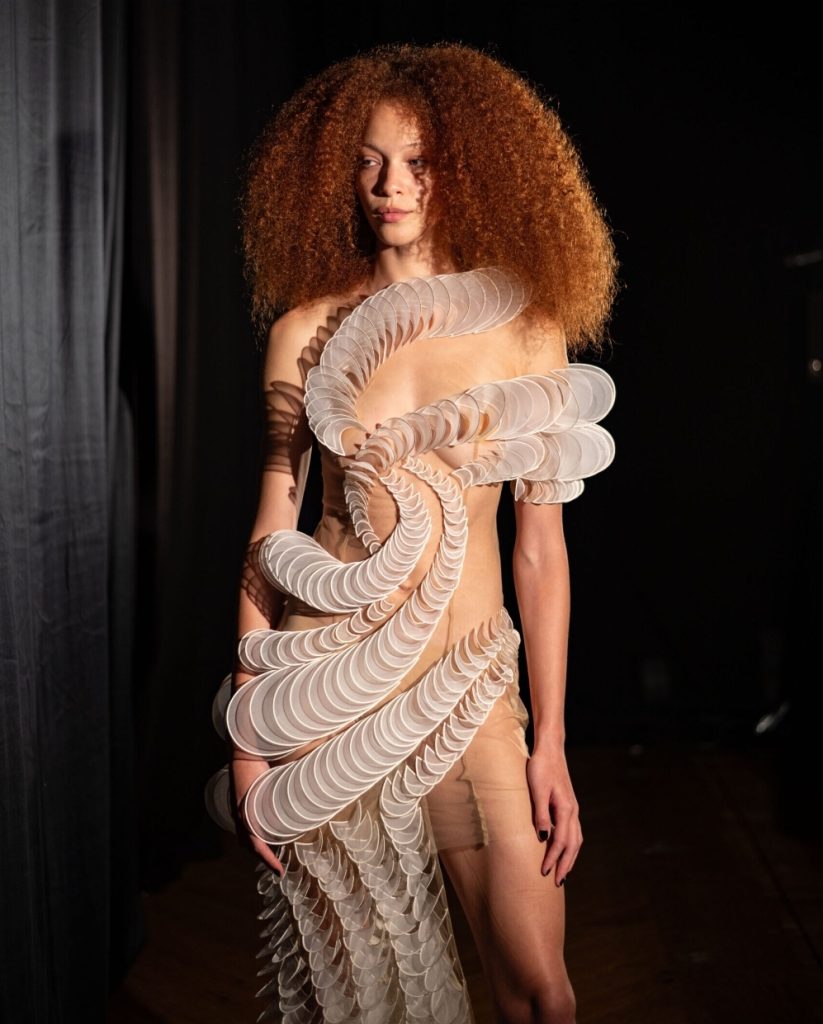The Future of Fashion by Van Herpen And Spiber Inc.: A Revolutionary Partnership Takes Center Stage
Picture this: you’re watching Paris Haute Couture Fashion Week. Moreover, you witness something extraordinary unfolding. A bridal gown floats down the runway, but this isn’t ordinary fabric. Instead, it’s made from proteins brewed in a lab. Furthermore, this represents the future of fashion itself. Van Herpen And Spiber Inc. create a new paradigm in fashion designing.
This groundbreaking moment happened when Spiber Inc. and Iris van Herpen joined forces. Additionally, their collaboration showcased at Paris Haute Couture Fashion Week AW2025 changed everything. The partnership demonstrates how science and art can transform fashion. Meanwhile, it proves that sustainability and beauty aren’t mutually exclusive.
Two Visionaries, One Shared Dream
Both companies started their journeys in 2007. Similarly, both pursued radical experimentation from day one. Spiber focused on biomaterial engineering. Conversely, van Herpen explored avant-garde couture design. Nevertheless, their paths converged around a shared philosophy.
Their collaboration signals something profound. Specifically, it shows how creativity, technology, and sustainability interconnect. Rather than treating these as separate pursuits, they unite them. Consequently, they’re creating an entirely new material narrative.
Nature as the Ultimate Teacher
Both creators draw inspiration from nature itself. Van Herpen captures nature’s forms and rhythms in her designs. Similarly, Spiber engineers proteins based on natural examples. They study spider silk, cashmere fibers, and silk cocoons. Furthermore, they create materials that nature never made.
This biomimicry approach drives both companies forward. “Biomimicry is ever-present in Spiber’s approach,” van Herpen explains. “That is truly similar to our own methods.” Moreover, both teams share exceptional attention to detail. They focus intensely on texture and sensorial qualities.
The Science Behind the Magic
Spiber’s Brewed Protein™ fiber represents a manufacturing breakthrough. Indeed, it’s the only industrialized man-made protein fiber globally. This achievement positions Spiber as a biomaterials leader. Additionally, the material offers unique properties that designers crave.
The fiber brings lightness and softness to garments. Furthermore, it creates fabric that floats around skin naturally. Van Herpen describes its “attractive, organic, and natural presence.” Meanwhile, the material embodies qualities that traditional fabrics cannot match.
Crafting the Perfect Bridal Vision
The collaboration’s centerpiece showcases intricate craftsmanship. Specifically, sheer organza gets cut into gradient-sized moon shapes. Then, heat-bonding attaches them to laser-cut Brewed Protein™ fabric bonings. Subsequently, hundreds of white coral petals are stitched upward. Finally, they spiral down into a translucent twisted train.
This construction demonstrates both technical mastery and artistic vision. Moreover, it proves that sustainable materials can achieve haute couture standards. The process combines traditional craftsmanship with innovative materials. Consequently, it creates something entirely new.
Beyond Fashion: A Statement of Possibility
This collaboration transcends mere runway presentation. Instead, it represents a blueprint for future innovation. Both companies believe cross-disciplinary collaboration is essential. Furthermore, they recognize fashion’s environmental challenges require collective solutions.
Kazuhide Sekiyama, Spiber’s Co-founder, emphasizes this vision. “We believe in the expressive power of materials,” he states. “Their ability to tell stories, to inspire emotion.” Additionally, he highlights materials’ power to redefine our relationship with nature.
The Analytical Framework: Why This Matters
From a customer experience perspective, this collaboration addresses multiple pain points. Firstly, consumers increasingly demand sustainable options. Secondly, they want products that don’t compromise on quality. Additionally, they seek brands that align with their values.
Traditional fashion production faces significant challenges. Specifically, it relies heavily on resource-intensive processes. Moreover, it often involves animal welfare concerns. Furthermore, environmental impact continues escalating. Consequently, consumers are seeking alternatives.
Market Positioning and Differentiation
Spiber’s approach creates distinctive competitive advantages. Their precision fermentation technology enables molecular-level protein engineering. Subsequently, this produces versatile materials tailored to specific needs. Furthermore, the plant-based ingredients offer environmental benefits.
The company’s strategic positioning targets multiple industries. These include apparel, food, and automotive sectors. Additionally, their technology platform approach enables scalability. Moreover, it creates opportunities for customization across applications.
Innovation Through Collaboration
This partnership demonstrates innovation methodology at its finest. Both companies leverage their core competencies effectively. Spiber contributes advanced biomaterial technology. Meanwhile, van Herpen brings haute couture expertise. Together, they create solutions neither could achieve alone.
The collaborative process involves shared exploration and experimentation. Furthermore, it requires aligning different organizational cultures. Additionally, it demands bridging technical and creative languages. Nevertheless, the results justify these challenges.
Future Implications and Industry Impact
This collaboration signals broader industry transformation. Specifically, it demonstrates how biotechnology can revolutionize fashion. Moreover, it proves that sustainability can enhance rather than compromise quality. Additionally, it shows how scientific innovation can inspire artistic expression.
The partnership’s impact extends beyond immediate participants. Indeed, it influences industry standards and expectations. Furthermore, it encourages other companies to explore similar collaborations. Consequently, it accelerates sustainable fashion adoption.

The Road Ahead
Both companies express commitment to continued collaboration. Their teams will explore new possibilities together. Furthermore, they share ambitions to push material innovation boundaries. Additionally, they aim to reimagine fashion’s future entirely.
This ongoing partnership promises exciting developments. Moreover, it demonstrates that sustainable innovation requires long-term commitment. Furthermore, it shows how shared values can drive meaningful change.
Conclusion: A New Paradigm Emerges
The Spiber-van Herpen collaboration represents more than a single runway moment. Instead, it marks a paradigm shift in fashion innovation. By combining scientific precision with artistic vision, they’re creating new possibilities. Furthermore, they’re proving that beauty and sustainability can coexist.
Their work offers hope for fashion’s future. Moreover, it demonstrates how collaboration can solve complex challenges. As consumers increasingly demand sustainable options, partnerships like this become essential. Ultimately, they’re not just creating beautiful garments—they’re crafting a better world.

